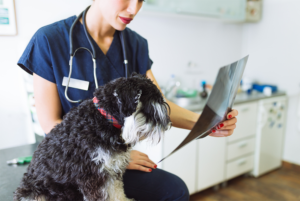Pet Imaging & Ultrasound

When your pet is sick or injured, veterinary medical imaging can help us get a closer look to find out what’s wrong and determine the best course of action. We like our pet owners to be informed, so here’s some info on what medical imaging is, what options are available, and how it may affect your pet.
WHAT IS MEDICAL IMAGING?
Medical imaging is a non-invasive way for us to “see inside” your pet to diagnose disease and injury. We offer several types of imaging including digital radiographs and ultrasound. Imaging includes radiology or cardiology consultations.
Some reasons your pet may need medical imaging include:
- Abnormal bloodwork
- Ongoing vomiting or diarrhea
- Weight loss
- Chronic Infections
- Lack of appetite
- Change in urinary habits
- Re-check of previous issue
- Cancer staging
- Fluid in chest or abdomen
- Pregnancy
- Suspicion that pet has swallowed a foreign object
DIGITAL RADIOLOGY
Radiology – also known as x-ray imaging – has been in use for many decades. It’s the most commonly used veterinary imaging procedure, and we use the most advanced digital method to produce crystal clear images. The process is the same as for humans, but on a smaller scale for pets. The x-ray procedure is painless, but some pets may need to be sedated to minimize anxiety and stress and allow for easier positioning and stillness while the images are taken. The amount of radiation your pet is exposed to is minimal and harmless
X-rays work well for imaging bones, large body cavities, and foreign objects, and can help detect the following:
- Tumors
- Arthritis
- Pneumonia
- Fractures
- Injuries
- Deformities
- Infections
X-rays are a standard diagnostic starting point, and if they don’t provide enough information to pinpoint your pet’s problem, they will help us determine what other tests might be needed for us to make a diagnosis.
ULTRASOUND
Ultrasound is the next most commonly used imaging procedure. Ultrasound uses high-frequency sound waves, which are not detectable by humans or pets, to create images from the echoes reflecting off of tissues and organs, and is better at producing images of soft tissues than x-rays.
The doctor will perform a scan by pressing a wand against the animal’s body, such as the abdominal wall or heart. Sound waves are directed at different parts of the body by moving the wand. The echoes are created as the sound beam changes speed while passing through tissues of varying density. The echoes get converted into electrical impulses that get converted into an image that represents what the tissues look like. Images can be viewed real-time as the wand is moved across the body. Ultrasound shows the shape and size of organs, and can show any abnormalities within them.
Ultrasound is non-invasive and painless and poses no risk for complications.

